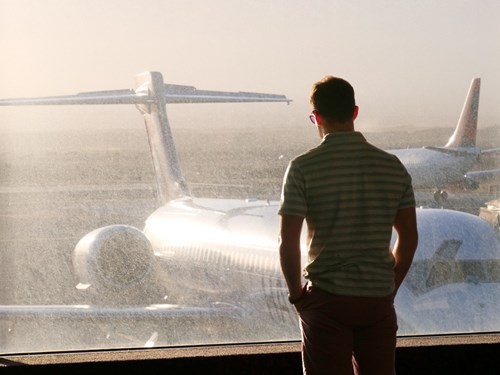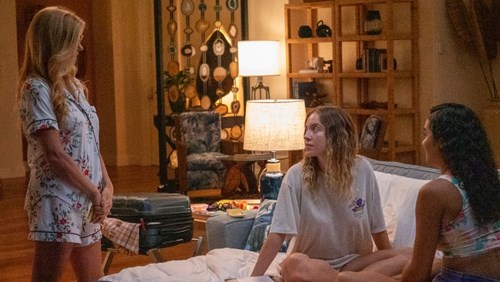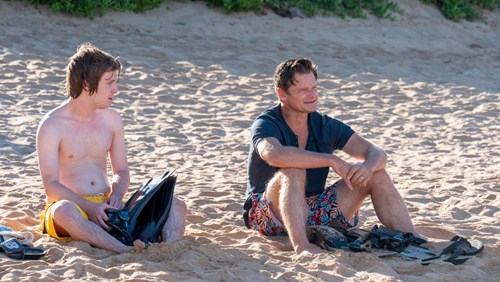by Robin Milling, Below the Line
The natural beauty of Hawaii with its golden hues and glorious sunshiny surf can’t help but lend itself to the stunning look of The White Lotus. However, according to Cinematographer Ben Kutchins, it also posed a significant challenge with changes in weather and utilizing real world outdoor sets such as the beach.
The six-episode limited series on HBO and streaming on HBO Max is shot entirely on location on the island of Maui. Behind the lens, accomplished cinematographer Kutchins [a two-time Emmy nominee for Ozark] used a fly-on-the-wall camera technique which exploits the various guests and employees over the span of a week at an exclusive tropical resort. It’s almost voyeuristic, and you never quite know what they’re hiding. Kutchins, with the encouragement and leeway of creator/writer/director Mike White, got to expose the darkness as well as the light of the characters in the show.
Below The Line spoke with Kutchins about his indoor and outdoor tricks of the trade while filming The White Lotus. He also shared his beginnings as an intern with Lucasfilm and how that shaped the way he approaches film making today. The phone never did ring from George Lucas, but he tells a great story about recently getting to work with Sir Paul McCartney on a video short, Find My Way.

Ben Kutchins
Below The Line: Talk about shooting in Hawaii. How does the natural beauty help or hinder your cinematography?
Ben Kutchins: The real tough thing about shooting in Hawaii is the weather. You’re very much just out in nature and whatever is happening in nature is happening on your set. None of this was shot on a stage. All of it is practical, hotel rooms, which proved very challenging. Sometimes there would be cloud cover and clouds and sun all day. That’s difficult to maintain any sort of continuity. Shooting in locations where there were no big lights outside the windows. It was all sort of practical light. In terms of the natural beauty, it was such an interesting challenge to create something that had a sort of ominous feeling in a place that’s so beautiful and lean into a new perspective on it.
BTL: How would you describe that new perspective?
Kutchins: We’ve all seen a million movies set in Hawaii or in the tropics that are mostly a very romantic view of what it is. I found it fascinating that how do we capture that natural beauty and turn it into something where you’re seeing the darkness in everyone. I think that’s sort of the magic of the show in that you’re watching each character, and you can see a part of yourself that you don’t like in each character. We’ve all sort of been in those character’s shoes and felt wronged or belittled, and then possibly behaved in ways that we’re not proud of. My constant goal was how do we find the darkness inside each of these characters; the darkness and the light.
BTL: Your camera is like a fly on the wall, almost like a peeping Tom.
Kutchins: I think it was important to have almost a voyeuristic view at some point. There were times when we were creating that voyeuristic view. For example, at the end of episode one, this idea that we are in the room and slowly pull back out of the room as Rachel (Alexandra Daddario) and Shane (Jake Lacy) begin to have sex, and we’re pulling back slowly to reveal these curtains blowing in the wind. It’s a beautiful, tender moment between them, but also it feels like we’re watching something we shouldn’t watch. I love an edit that Mike left that shot a little bit too long. It very much brings out that sense of voyeurism. We’re peeping into these people’s lives in a way that should make you uncomfortable. We’re learning a little too much about them. I think that’s one of the reasons that people responded to the show.

Jake Lazy in The White Lotus
BTL: There is the coolest shot in the airport where Jake Lacy’s character Shane is looking at the planes through the dingy window. How did you do that?
Kutchins: This was shot in an old part of a Maui airport that’s being renovated, but it’s kind of cool to see that it has this old-school vibe to it. When we first walked in, it was a little daunting like “I don’t know how I’m going to make this place look like a modern airport,” but then I kind of leaned into it being this quaint airport for a small resort even though there were 747s outside. We leaned into the vibe of it and I changed out the fluorescent tubes and even left some of the old ones to leave it a little bit green and let it be a little bit dirty. We scouted it early in the morning when we shot it and I saw the sun kind of rise right through, and we knew there would be this moment of him looking out (SPOILER!) at the body being loaded onto the plane. I said if I shoot this at say 7:45 the sun is going to be streaming in perfectly. Fortunately, Mike White was always up for whatever ideas I had visually, and we embraced that sort of flare moment of him looking out at the plane.
BTL: What was your color palette?
Kutchins: I created a lookup table of the show as a whole, which was predominantly a very golden hue and slightly dark. I thought it would be really interesting to create a very strong color palette for the show. I’m a strong believer in a forcible use of color. You might have noticed that in Ozark. I believe in a strong sense of color to give a sense of place. I think color and contrast are the things of our memories and our dreams. I mean, we dream in technicolor. I think when we remember a magical moment in our lives, our sense of color and time and place and smell is all very heightened. I think in everything that I do I’m always trying to gain a real sense of time and place that feels like something you might’ve experienced in your life, and you’re looking back on this moment.
BTL: It must’ve been tricky getting the light just right on the beach scenes.
Kutchins: It was a testament to Mike’s trust. I had never worked with him before. Early on in prep, I was pushing him and our Assistant Director Justin Ritson to basically shoot in the beginning of the day and the end of the day and find something else to do in the middle of the day when the sun is unkind to the actors. I was pushing to completely rejigger the schedule to be there in the morning and in the evening so that the light was more kind to the actors. There are a few scenes in the series where we shot on the beach, but we could cover the actor with an umbrella. For the most part, it was scheduling shenanigans to get it at the time when the light was right. Often times I’d be guessing about the weather for the day and sort of praying. A lot of hard work went in by my grips. I’m very friendly with my grips, because I work them very hard, and my key grip Manny Duran definitely earned his paycheck on this one.

A scene from The White Lotus
BTL: Describe how you shot the indoor hotel room scenes.
Kutchins: The hotel rooms were very challenging. The apartment that I’m sitting in has higher ceilings than those hotel rooms. For whatever reason, the hotel rooms where we shot has very low ceilings and nowhere to hide any lights. The greatest challenge of being a DP is trying to balance the natural environment that’s through your window with the interior light. A lot of stages or sets have removable ceilings or panels that you can put a light through. It was really difficult, so I basically came up with this system of being able to tack up fluorescent tubes, these Astera tubes that are color controllable around the room in the corners. Then if we’re seeing that corner, we would pull them down. My key grip and gaffer did a great job rigging that. To be honest, there wasn’t much I could do in those rooms because they were so small. Just trying to hide a light sometimes was a person holding a light off-camera. It was not the easiest thing I’ve done in my career (laughs).
BTL: Going back to your beginnings, what was your biggest takeaway interning at Lucasfilm?
Kutchins: It was an opportunity to play with film stock, because we were still shooting film. I worked in the still photography department, where we were doing a lot of referenced photography and shooting things on film stock. It was actually like motion picture stock but putting it into the still camera. We had a whole color darkroom, so what I really did there was I experimented with pushing and pulling film and see what would happen when you pushed it to its limit. I think the real takeaway for me was with White Lotus or the look of Ozark or anything I’ve shot, is something that I developed there when I was sort of pushing and pulling film and really pushing organic film stock to its most extreme in terms of contrast, color, what happens to the highlight, what happens to the shadows. I think a lot of looks in my mind of what the world looks like and the way I see the world photographically. I started there when I was 19 years old, so it was very early on in my film career. The second thing is I got to see some really great DPs who were working at that time and lighting sets. I sort of pulled back the curtain of the magic of filmmaking. It was that aha moment of, “I know what I want to do now.”

Fred Hechinger & Steve Zahn in The White Lotus
BTL: Did George Lucas ever reach out to hire you for a project?
Kutchins: (laughs) No, I’m still waiting by the phone. I think I met him twice, and he’s a real gentleman, but he has not reached out yet. I’m still waiting patiently. Call me George.
BTL: Yes, but you got to work with Sir Paul McCartney for the video short Find My Way. It doesn’t get any better than that.
Kutchins: I’d worked with a lot of celebrities up until this point, and it was probably the only time in the last decade that I’d been really nervous. I think I mumbled something about my dad working in the music industry (he managed The Youngbloods) which was my childhood. I think I mumbled that I grew up with his music. Then I was worried that would maybe make him feel old, so I stopped. It was not my most graceful moment. He was such a gentleman, and he was around most of the day we were shooting, even though he’s in the video for a very brief moment. He hung out most of the day and then when he was leaving he came and found me and said, “what a pleasure to meet you,” which he didn’t have to do. It’s nice when you meet your idols, and they’re kind and gentle. It’s a great reminder to us all to always be kind and gentle.
BTL: That makes sense as to why you do a lot of music-based films and television.
Kutchins: Oh, yeah. I grew up on the road, sometimes with the band while they were on tour. Some of my earlier memories are on a tour bus.
BTL: That’s a whole other interview! Getting back to The White Lotus, where does that theme come from that you’re also looking for the darkness with the light?
Kutchins: I think I’m just always looking to push whatever the story is, to be adventurous as to how things can look and feel. I’m most interested in the things we hide, the little lies that we tell ourselves and the people around us. I think in a way all of these people in the show are doing the best that they can, but they might be a little delusional and a little wrapped up in their own delusion. The way that I know how to express that is by creating parts of the frame that are both light and dark. There’s ways in which we’re all hiding, and I think it’s important for me to try to express that, and in this series, to express that with shadow.
The White Lotus can be watched on HBO and streaming on HBO Max.
All photos courtesy HBO – Photographer: Mario Perez — except where noted.